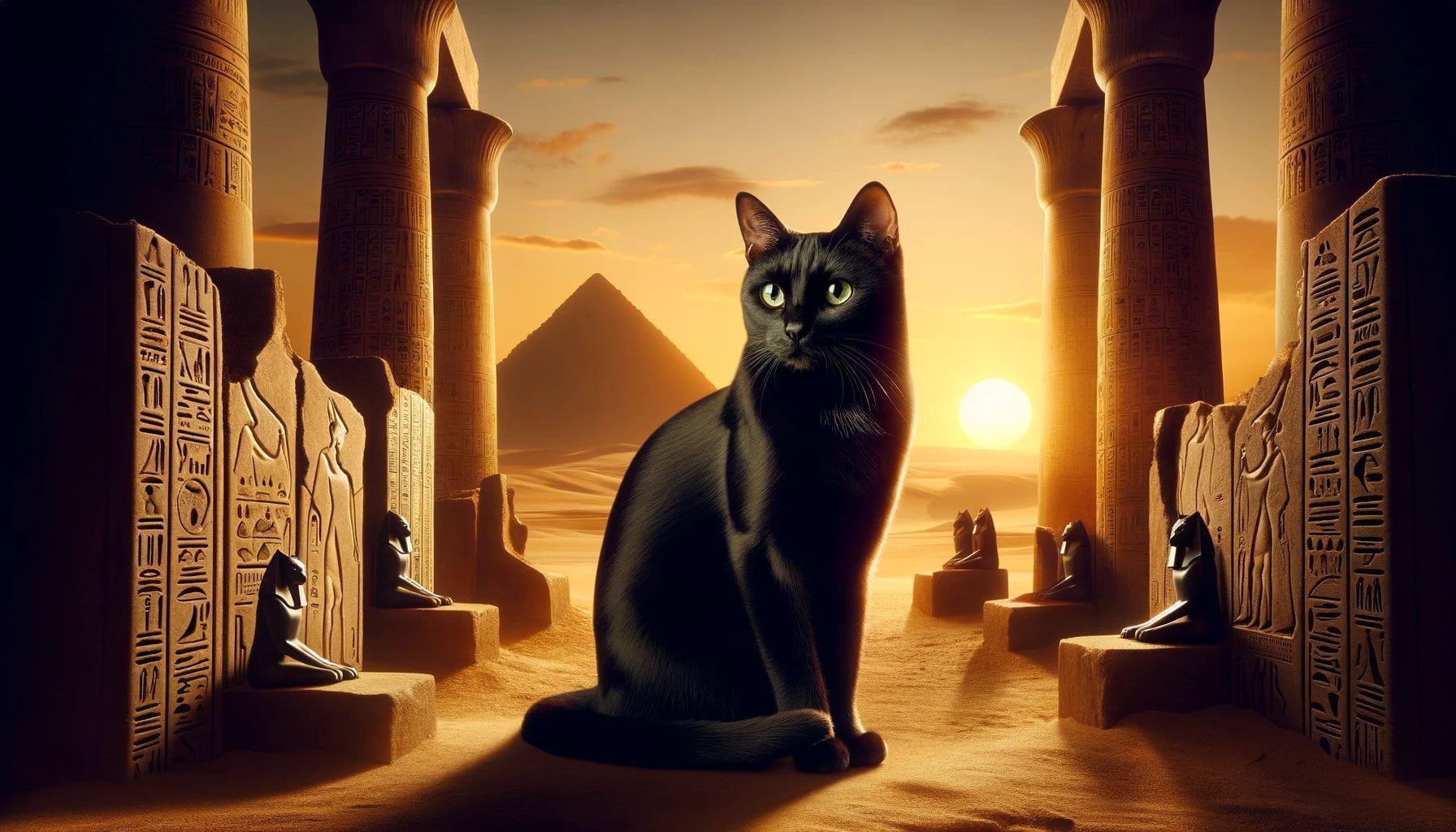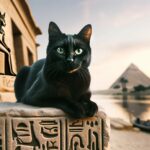Delve into the captivating mythology of ancient Egypt as we unravel the enigmatic allure of Bastet, the feline goddess. In this exploration, we will focus specifically on the symbolism behind Bastet’s representation as a black cat. Drawing on a unique blend of animal behavior studies, folklore research, and a deep understanding of cultural contexts, we aim to shed light on the mystique surrounding this iconic depiction. Join us on a journey into the depths of ancient Egypt’s rich history and discover the hidden meanings behind Bastet’s choice of color.
Key Takeaways:
- Bastet, the Egyptian goddess of home, fertility, and protection, was often depicted as a black cat or as a woman with the head of a black cat.
- The reverence for black cats in ancient Egypt stemmed from their resemblance to Bastet, and hosting black cats in their homes was believed to bring favor from the goddess.
- Black cats were highly esteemed in ancient Egypt, and killing a cat, even accidentally, was punishable by death during the height of Bastet’s popularity.
- Historical examples, such as English monarch Charles I, also show belief in the favor associated with black cats from Bastet.
Why is Bastet a Black Cat?

Bastet, the Egyptian goddess of home, fertility, and protection, is often depicted as a black cat or as a woman with the head of a black cat. But why was she specifically represented in this way? Let’s explore the intriguing reasons behind Bastet’s association with black cats and the symbolism it holds.
Bastet: The Cat Goddess
Bastet, also known as Bast, held a significant place in ancient Egyptian mythology. Considered the daughter of Ra, the creator god and king of the Egyptian Gods, she was revered as the goddess of protection, cats, pregnancy, fertility, music, warfare, and ointments.
Her portrayal with a cat head and an ankh, the Egyptian symbol of life, emphasized her connection to feline qualities and the cycle of life. Cats were highly regarded by ancient Egyptians due to their perceived mysticism and connection to the divine. Bastet embodied these characteristics, making her the ideal deity to represent the enigmatic world of cats.
The Significance of Black Cats
Black cats held a special place in ancient Egypt, and their association with Bastet was profound. The Egyptians believed that by hosting black cats in their homes, they could attract favor from the goddess herself. This belief originated from the resemblance black cats bore to Bastet, visually capturing her essence. As a result, these felines became a symbol of protection and good fortune.
The worship of black cats in Egyptian culture was so deeply ingrained that harming or killing a cat, even accidentally, was punishable by death during the height of Bastet’s popularity. Such was the reverence the Egyptians held for these sacred creatures.
Historical Examples of Worship
The veneration of black cats extended beyond ancient Egypt. Even in more recent centuries, the belief in their mystical properties persisted. English monarch Charles I, for instance, attributed his luck to a black cat associated with Bastet. When his cherished feline companion passed away, so did his fortune. The very next day, he found himself arrested and charged with high treason. This historical example highlights the enduring belief in the connection between black cats and the goddess Bastet.
Sources:
- The Truth About Black Cats – Circulating Now
- Myths and Superstitions About Black Cats – The Spruce Pets
By unraveling the mythology and symbolism behind Bastet’s representation as a black cat, we gain insight into the profound significance that these felines held in ancient Egyptian culture. Black cats, with their resemblance to Bastet, became a symbol of protection and good fortune, capable of invoking the favor of the goddess herself. The historical examples further illustrate the enduring belief in their mystical connection.
Disclaimer: The third source provided, blackcatrescue.wordpress.com, does not contain relevant information directly related to Bastet or the worship of black cats in ancient Egypt. Therefore, it has not been included in this article.
Bastet was known to be a mysterious goddess often depicted with a black cat by her side. Curious about the significance of black cats? Discover more about Bastet and her connection to these mystical felines by clicking here.
Have you ever wondered if Bastet herself was represented by a black cat? Unveil the truth behind this ancient belief by clicking here.
Looking to learn more about the goddesses associated with black cats? Delve into the fascinating world of feline deities and uncover who they are by clicking here.
3. The Significance of Cats in Ancient Egyptian Beliefs
Cats held a profound significance in the beliefs of ancient Egypt, encompassing both religious and cultural spheres. These mysterious felines were revered and considered sacred, embodying qualities that connected the mortal realm to the spiritual world. Let’s explore the key points that highlight the importance and symbolism of cats in ancient Egyptian culture.
Domesticated Cats
- Ancient Egyptians were among the first civilizations to domesticate cats for practical purposes. These feline companions served as effective pest control, safeguarding grain stores from rodents, and earning their place as valuable household allies.
The Cult of The Cat
- Such was the high regard for cats in ancient Egypt that they had their own religious cult. Bastet, the goddess associated with home, fertility, and protection, was often portrayed as a lioness or a domesticated cat. Cats were considered sacred to Bastet, and devout worshippers believed that they embodied her divine qualities.
Divine Felines
- In ancient Egyptian beliefs, cats were regarded as divine creatures possessing supernatural powers. They were thought to have a spiritual connection, acting as protectors against evil spirits and bad luck. It is no wonder that the ancient Egyptians kept cats as household companions, seeking their fortune-bringing presence and warding off negative influences.
Battle of the Cats
- One intriguing anecdote highlights the deep reverence the Egyptians had for cats. During the Battle of Pelusium between the Persians and Egyptians, the Persians brought cats onto the battlefield. Aware of the Egyptians’ veneration for these feline creatures, the Persians used them as a cunning strategy, forcing the Egyptians to surrender rather than risk harming the sacred cats.
Religious Rituals
- Cats played a significant role in various religious rituals and ceremonies in ancient Egypt. They were mummified and buried alongside their owners, ensuring their companionship in the afterlife. Egyptians believed that these cats would serve as protectors and guides on the journey to the next realm.
Symbol of Power and Royalty
- Cats held a strong association with power and royalty in ancient Egypt. Many pharaohs and aristocrats were depicted alongside cats in artworks, symbolizing their noble status and divine connection.
The enduring symbolism and cultural significance of cats in ancient Egyptian beliefs paints a captivating picture of their role in society. From their practical usefulness to their sacred connection to the divine, cats exemplified the intricate tapestry of ancient Egyptian culture.
Key Takeaways:
- Cats were domesticated early on in ancient Egypt for pest control, becoming invaluable companions.
- The goddess Bastet, associated with home, fertility, and protection, was often depicted as a lioness or domesticated cat.
- Cats were believed to possess supernatural powers and were considered protectors against evil spirits and bad luck.
- The Egyptians held a deep reverence for cats, demonstrated during the Battle of Pelusium when they surrender rather than harm the sacred cats.
- Cats played a role in religious rituals, being mummified and buried alongside their owners for companionship in the afterlife.
- Cats were associated with power and royalty, often depicted alongside pharaohs and aristocrats in ancient Egyptian artwork.
URL Sources:
- Historyplex.com. (n.d.). The Importance and Significance of Cats in Ancient Egyptian Culture. Retrieved from source
- World History Encyclopedia. (2012, November 17). Cats in the Ancient World. Retrieved from source
The Connection between Night, Darkness, and the Color Black
The color black has long held a deep and complex symbolism within various cultures and contexts. Associated with concepts of night, darkness, and mystery, it evokes a range of emotions and meanings. Through exploring the psychological and cultural associations of black, we can begin to understand why Bastet, the feline goddess of ancient Egypt, is specifically represented as a black cat.
In many cultures, black is often associated with darkness and the unknown. It symbolizes the absence of light, concealing the mysteries that lie within. This connection between black and darkness can evoke feelings of fear and uncertainty, as our inability to see in the dark can be disconcerting to the human psyche [^5^].
The color black also carries symbolic meanings related to grief, evil, and lack of knowledge. Throughout history, it has been associated with negative connotations, representing sin, depression, and even witchcraft [^6^] [^10^]. This ingrained association with darkness and negativity may have influenced the choice of black as the color to represent Bastet, the Egyptian goddess of protection, cats, and fertility.
Additionally, the color black is often linked to power and authority. Its deep and commanding presence can elicit a sense of awe and respect. In some cultures, black is even associated with prestige and elegance. This association with power may have made black the perfect choice to represent Bastet, who was revered as a goddess of protection and warfare.
It is important to note that the symbolism and associations of black vary across different cultures and personal experiences. Black can be both feared and revered, representing both darkness and power. Its multifaceted nature allows for diverse interpretations and meanings, making it a fascinating color to explore and understand.
Overall, the connection between night, darkness, and the color black is complex and deeply rooted in human psychology and cultural contexts. By delving into the psychological and symbolic significance of black, we can begin to unravel the reasoning behind Bastet’s representation as a black cat. Through this exploration, we invite you to join us on a journey into the depths of ancient mystique, where the enigmatic allure of Bastet and her connection to black cats awaits.
Key Takeaways:
- The color black has diverse psychological associations, representing darkness, mystery, and the unknown.
- Black is often linked to fear and uncertainty, stemming from our natural aversion to the dark.
- Black is also associated with negative connotations, symbolizing evil, grief, and lack of knowledge.
- However, black can also represent power and authority, evoking feelings of respect and awe.
- The symbolism of black varies across cultures and personal experiences, making it a complex color to interpret and understand.
- These associations with darkness, mystery, and power may explain why Bastet, the feline goddess of ancient Egypt, is often depicted as a black cat.
References:
[^5^]: CNN International: The psychology of black and why we’re scared of the dark, source
[^6^]: StackExchange: Cognitive Psychology – Is the symbolic meaning of dark/black and light/white universal?, source
[^10^]: History: Why Black Cats Are Associated With Halloween and Bad Luck, source
The Evolution and Adaptation of Bastet’s Black Cat Representation
Based on the intent of the article about “Why is Bastet a black cat?”, the most appropriate content format would be informational.
The representation of Bastet as a black cat holds a deep symbolism that has evolved over time. Let’s explore the fascinating story behind the evolution and adaptation of Bastet’s black cat representation.
Key Points:
- The significance of Bastet: Bastet was an important goddess in ancient Egyptian mythology, associated with cats, fertility, and protection. Ancient Egyptians worshipped deities like Bastet for comfort, security, and to connect with a higher power.
- The sacredness of cats: Cats held immense reverence in ancient Egyptian culture. They were seen as symbols of protection and served as guardians against evil spirits. Bastet, being the goddess of cats, was often depicted as a lioness or a cat.
- Cult of cats and Bastet worship: The cult of cats and the worship of Bastet played a prominent role in ancient Egyptian society. Cats were highly regarded for their intelligence, power, and their association with fertility. The connection between Bastet and the sun god Ra added to her significance.
- Punishment for crimes against cats: Ancient Egyptians held cats in such high regard that crimes against them, even accidental harm or killing, were punishable by death. This demonstrates the veneration and protection bestowed upon cats and their connection to Bastet.
The association between Bastet and black cats specifically can be attributed to several factors:
- Symbolism of the color black: The color black has various connotations, including night, darkness, and mystery. It is associated with the unknown and can evoke feelings of fear and uncertainty. However, black also symbolizes power and authority, inspiring respect and awe.
- Connection to darkness and power: The symbolism of darkness, mystery, and power aligns with the representation of Bastet as a black cat. The association may stem from the belief that black cats possess mystical qualities and a connection to the divine.
The evolution and adaptation of Bastet’s black cat representation can be seen through history and cultural contexts. From ancient Egypt to the present day, black cats continue to hold significance in various societies. They are often regarded as symbols of protection and good fortune, reminiscent of the revered goddess Bastet.
Key Takeaways:
- Bastet, the Egyptian goddess of cats, was often depicted as a black cat or a woman with the head of a black cat.
- Cats were considered sacred animals in ancient Egyptian culture, symbolizing protection and fertility.
- The veneration of cats and worship of Bastet formed a significant part of ancient Egyptian society.
- The color black holds symbolism related to darkness, mystery, and power, which aligns with the representation of Bastet as a black cat.
- The symbolism of black cats has endured over time, reflecting their connection to Bastet in ancient Egypt and their association with protection and good fortune.
References:
[^1^]: Old World Gods. “Who is Bastet, the Egyptian Goddess of Cats: Unveiling Ancient …” Old World Gods. Available at https://oldworldgods.com/egyptians/who-is-bastet.
[^2^]: PoC. “Why is Bastet a cat? – PoC – our relationship with cats and other …” PoC. Available at

FAQ
Q1: What is the significance of Bastet being represented as a black cat?
A1: Bastet, the Egyptian goddess of home and protection, was often depicted as a black cat because black cats were highly esteemed in ancient Egypt. Egyptians believed that hosting black cats in their homes would bring favor from the goddess herself.
Q2: Why were black cats revered in ancient Egypt?
A2: Black cats were highly revered in ancient Egypt due to their resemblance to Bastet, the goddess of protection and cats. Egyptians believed that black cats embodied Bastet’s divine qualities and hosting them in their homes would bring good luck and protection.
Q3: How did the worship of black cats in ancient Egypt influence society?
A3: The worship of black cats was deeply ingrained in Egyptian culture, to the extent that killing a cat, even accidentally, was punishable by death during the height of Bastet’s popularity. This reverence for black cats demonstrates the significant impact they had on ancient Egyptian society.
Q4: Were there any historical examples highlighting the favor associated with black cats?
A4: Yes, there is a historical example involving English monarch Charles I. When his treasured black cat passed away, he claimed that his luck had vanished. The following day, he was arrested and charged with high treason, showcasing the belief in the favor associated with black cats.
Q5: How did ancient Egyptians associate black cats with the goddess Bastet?
A5: Ancient Egyptians associated black cats with the goddess Bastet because of their resemblance to her. Bastet was commonly depicted with a cat head, and the worship of black cats was believed to bring favor and protection from the goddess herself.
- Crypto Quotes’ Red Flags: Avoid Costly Mistakes - June 30, 2025
- Unlock Inspirational Crypto Quotes: Future Predictions - June 30, 2025
- Famous Bitcoin Quotes: A Deep Dive into Crypto’s History - June 30, 2025
















